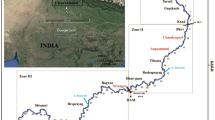Abstract
The Three Gorges Reservoir (TGR) began operation in 2003 with alterations in the natural hydrological regime and with severe environmental impacts. Baguazhou Reach, a goose-head pattern of braided channels in the lower Yangtze River has emerged due to a series of changes in the water and sediment conditions caused by the TGR. This paper makes simulations of the hydrodynamic characteristics under the condition of clear water releasing from the TGR and analyzes the features of deformation within the branches of the reach, as well as predicts the future development of the hydrodynamic improvement and the additional fluvial processes. The results show that the decline of the tributary is mainly due to the weakening of the inflow energy and the channel resistance. The particular protective measures can effectively improve the hydrodynamic performance and the present situation but, they all result in a deflection of the main water flow and increase the local velocity, and over the long term, leading to the deposition in the junction areas, where a special protection is required.
Similar content being viewed by others
References
Chen Y. D., Yang T., Xu C. Y. et al. Hydrologic alteration along the middle and upper East River (Dongjiang) basin, South China: A visually enhanced mining on the results of RVA method [J]. Stochastic Environmental Research and Risk Assessment, 2010, 24(1): 9–18.
Revenga C., Brunner J., Henninger N. et al. Pilot analysis of global ecosystems: Freshwater ecosystems [M]. Washington DC, USA: World Resources Institute, 2000.
Rosenberg D. M., Mccully P., Pringle C. M. Global-scale environmental effects of hydrological alterations: introduction [J]. Bioscience, 2000, 50(9): 746–751.
Shafroth P. B., Friedman J. M., Auble G. T. et al. Potential responses of riparian vegetation to dam removal [J]. Bioscience, 2002, 52: 703–712.
Stanley D. J., Warne A. G. Nile delta: Recent geological evolution and human impact [J]. Science, 1993, 266(5108): 753–762.
Eigenberg R. A global perspective on environmental flow assessment: Emerging trends in the development and application of environmental flow methodologies for rivers [J]. River Research and Applications, 2003, 19: 397–441.
Zhang Q., Chen Y. D., Jiang T. et al. Human induced regulations of river channels and implications for hydrological alterations in the Pearl River Delta, China [J]. Stochastic Environmental Research and Risk Assessment, 2011, 25(7): 1001–1011.
Stone R.. Three Gorges Dam: Into the unknown [J]. Science, 2008, 321(5889): 628–632.
Xu K., Milliman J. D., Yang Z. et al. Climatic and anthropogenic impacts on the water and sediment discharge from the Yangtze River (Changjiang), 1950–2005 (Gupta A. Large rivers: Geomorphology and management) [M]. Oxford, UK: Wiley, 2008, 609–626.
Liu Y., Li Y., Lu J. Spatio-temporal differences of fluvial process of goose-head-shaped anabranching river reaches [J]. Journal of Basic of Science and Engineering, 2015, 23(4): 705–714.
Li Y. S. Goose-head variation characteristics of braided river and its control measures [J]. Port and Waterway Engineering, 2013, (4): 114–116(in Chinese).
Surian N. Fluvial processes in braided rivers. Rivers-physical, fluvial and environmental processes [M]. Berlin, Germany: Springer International Publishing, 2015.
Gao B., Yang D., Yang H. Impact of the Three Gorges Dam on flow regime in the middle and lower Yangtze River [J]. Quaternary International, 2013, 304: 43–50.
Zhang Q. Influence of Three Gorges Dam on stream flow and sediment load of the middle Yangtze River, China [J]. Stochastic Environmental Research and Risk Assessment, 2012, 26(4): 569–579.
Zhu L., Ge H., Li Y. et al. Branching channels in the middle Yangtze River, China [J]. Journal of Basic of Science and Engineering, 2015, 23(2): 246–258.
Liu Z. H. Evolution and training of the Goose-head braided channel in middle and lower Yangtze River [J]. Yangtze River,1993, 24(12): 31–37(in Chinese).
Pan Q. S., Hu X. Y. Bifurcated channel stretches regulation in middle and lower Yangtze River [J].Journal of Yangtze River Scientific Research Institute, 2005, 22(3): 13–16(in Chinese).
Leng K., Luo H. C. The evolution characteristics and formation condition of Goose-Head pattern diverged channels in the middle and lower Yangtze River [J]. Journal of Hydraulic Engineering, 1994, (10): 82–92(in Chinese).
Hou W. G., Hu C. Y., Xie Z. T. Study on river regime evolution of Bagua Reach of Yangtze River and regulation counter measures in Nanjing City [J]. Yangtze River, 2011, 42(7): 39–42(in Chinese).
Yang H., Lin B., Zhou J. Avulsions in a simulated large lowland braided river [J]. Water Resources Management, 2018, 32(7): 2301–2314.
Javernick L., Redolfi M., Bertoldi W. Evaluation of a numerical model’s ability to predict bed load transport observed in braided river experiments [J]. Advances in Water Resources, 2018,115(5): 207–218.
Yang Y. P., Zhang M. K., Li Y. T. et al. The variations of suspended sediment concentration in Yangtze River Estuary [J]. Journal of Hydrodynamics, 2015, 27(6): 845–856.
Kuang C. P., Chen W., Gu J. et al. Comprehensive analysis on the sediment siltation in the upper reach of the deepwater navigation channel in the Yangtze Estuary [J]. Journal of Hydrodynamics, 2015, 26(2): 299–308.
Yu P., Tang H., Xiao Y. et al. Effects of a diversion dyke on river flow: A case study [J]. Water Management, 2015, 168(5): 210–219.
Author information
Authors and Affiliations
Corresponding author
Additional information
Project supported by the funding received by the National Key R&D Program of China (Grant No. 2016YFC0402501), the National Natural Science Foundation of China (Grant No. 51479071), the “111 Project” (Grant Nos. B17015, B12032) and the Jiangsu Colleges and Universities Academic Building Engineering Project (Grant No. YS11001).
Biography: Wen-hong Dai (1966-), Male, Ph. D., Professor
Rights and permissions
About this article
Cite this article
Dai, Wh., Ding, W. Hydrodynamic improvement of a goose-head pattern braided reach in lower Yangtze River. J Hydrodyn 31, 614–621 (2019). https://doi.org/10.1007/s42241-018-0152-0
Received:
Revised:
Accepted:
Published:
Issue Date:
DOI: https://doi.org/10.1007/s42241-018-0152-0




